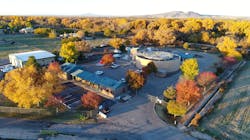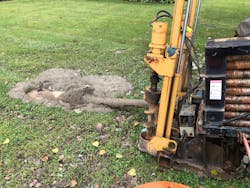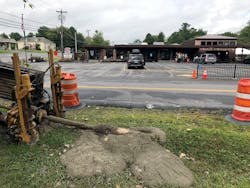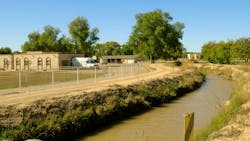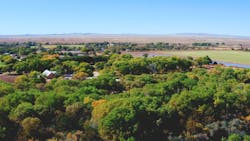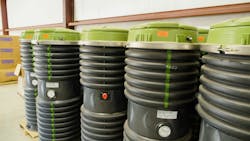The alluvial fields under the direct hydraulic influence of the Rio Grande in central New Mexico have sustained agriculture since their habitation by the ancestral Pueblo peoples who cultivated the “Three Sisters” of corn, beans, and squash.
The historical farming traditions which molded the identity of the early incarnations of the Town of Peralta and Bosque Farms never disappeared. Instead, alfalfa and other grasses, even a certified organic lavender farm, have replaced most food crops. Horses and chickens became pets. Strip centers are the new trading posts which once formed the backbone of the fabled Camino Real (royal road) hugging the river. Families tracing their genealogies to the earliest inhabitants still reside in the area while its enduring rural ambiance is increasingly coveted by retirees and daily commuters to Albuquerque, which is only 20 miles north.
Contaminated Water
By the mid-1990s, neighboring Bosque Farms and the Town of Peralta realized other timeless customs of their shared heritage needed an urgent change: the cesspools and septic tanks used by residents were polluting their groundwater and shallow wells (from 35 to less than 200 feet deep).
“There were cesspools and some instances of sanitary sewer lines from buildings going into irrigation drains,” Clayton H. Ten Eyck, P.E., senior professional engineer and water resources project manager of Molzen Corbin in Albuquerque, said.
“With the high water table there’s really very limited soil treatment occurring through the leach fields,” Ten Eyck added. “There were instances where you’ve got a failed and flooded leach field and you can look across the fence and see your neighbor’s domestic water well is within tens of feet of it.”
Although cut from the same cloth, Bosque Farms and Peralta — only a few miles apart — didn’t share the same socioeconomic circumstances which might have allowed a partnership to migrate from onsite systems to a proper sewer infrastructure. Whereas Bosque Farms incorporated as a municipality in 1974, the Town of Peralta did not until 2007. While similar in size (both with a population of approximately 3,500 to 4,000 and footprints of about four square miles each), the median household income for Bosque Farms exceeds that of the Town of Peralta and its poverty rate is lower. By the 1990s, Bosque Farms already had a municipal water system. Peralta’s residents still depend on private, individual wells.
Onsite System Abandonment
Anxious to protect the drinking water in its deeper basin-fill aquifer from high nitrate levels generated by the town’s malfunctioning onsite wastewater apparatus, Bosque Farms implemented a project in 1995 to abandon septic systems and construct a sewer system and a wastewater treatment plant (WWTP).
Molzen Corbin presented Bosque Farms with four options: conventional gravity, vacuum sewers, septic tank effluent pumps (STEP) and a low-pressure sewer system with grinder pumps.
Much of the area encompasses a flat valley floor within the Rio Grande’s flood plain with scattered foothills, high groundwater (four to 10 feet) and a patchwork of unlined irrigation canals, laterals and drains. The construction of each system also would have to consider seasonal irrigation, aquatic life, livestock watering, the public water supply, wildlife habitat and numerous archaeological sites.
Evaluating Alternatives
The choices Molzen Corbin put before Bosque Farms basically mirrored those it issued almost 20 years later in a preliminary engineering report for the Town of Peralta.
A gravity system, the report said, would entail “excessive construction costs” due to gravity mains situated up to 15 feet deep; removal and replacement of most of the existing pavement; land acquisition for lift stations; and disruption to homeowner property.
The vacuum system — where sewage from each residence is discharged into a valve pit and transported via vacuum to a central lift station before pumping to the WWTP — had steep operating costs and involved land acquisition for vacuum stations. Many dwellings are located so far from the street that a four-inch gravity line from the house to the valve pit in the road would require disruptive excavation similar to that of a gravity system in the resident’s yard. Furthermore, according to Molzen Corbin, if a vacuum valve sticks open at a home, all the vacuum mains in the subarea will lose vacuum and the vacuum valves on that main will not operate.
Many residences utilized septic tanks, but the engineering firm concluded that given their age and need of repair they should be replaced with a new interceptor tank, effluent pump, and effluent filter. While each individual tank would collect solids, the STEP process would demand an effluent sewer to convey effluent to another location for treatment and disposal. Problems still might persist as there are few means of enforcing groundwater protection from poorly managed septic tanks. Like gravity and vacuum systems, STEP specified extensive dewatering.
Appropriate Technology
Molzen Corbin recommended the All-Terrain Sewer™ (ATS) manufactured by Environment One Corporation (E/One) of Niskayuna, N.Y., which invented low-pressure sewers in 1969. The system begins with a grinder pump station that blends solids into a fine slurry and is anchored by a 1 hp semi-positive displacement pump which enables complex pressure sewer system designs because of its nearly vertical pump curve and the resulting predictable flow. The robust torque generated by the pump can push wastewater through small-diameter (2”-4”) inflow-and-infiltration-free pressurized plastic pipes buried just below the frost line for a distance of more than two miles — or even straight up 186 feet.
The ATS, Molzen Corbin concluded, would eliminate exfiltration, infiltration, inflow, manholes and lift stations, and allow installation of pipe in shallow trenches or utilizing horizontal directional drilling’s minimal impact to infrastructure or private property. Floodplains and wetlands would not be affected. Historical and archaeological resources would remain intact. Narrow rights of way along municipal streets and private roads could be respected.
“There were a lot of reasons that came into play in selecting the ATS versus a conventional system,” Ten Eyck said. “In terms of crossing all of the ditches, they will allow you to do open cut excavation from November to May when they’re not actively utilizing the ditches. But, outside that window you cannot open excavate across them so you have to do a trenchless method like a horizontal directional drill.”
A further “convenience to the ATS,” Ten Eyck added, “is that it’s pressurized, so we’re less concerned about maintaining grade as we do one of these crossings, how deep do we have to go and how does that impact up and downstream sewer? We can simply go underneath it and come back up.”
Progressing Cavity Advantage
The progressing cavity design of the E/One pump also made it attractive to Molzen Corbin’s engineers.
“There are a lot of individual grinder pumps on the market, most of them are a centrifugal style of pump,” Ten Eyck said. “One of the benefits we see with the progressing cavity is it continues to move regardless of who else has their individual grinder pumps operating versus with the centrifugal pumps, if you have too much flow in the line you hit the shut-off head in the pump and you’re not moving sewage until that pressure drops low enough.”
Fitting the Circumstances
Whether the project entails new construction or septic-to-sewer conversions, an advantage of pressure sewers is that every lot, its geographic location notwithstanding, can be unlocked. In the case of Bosque Farms and the Town of Peralta, engineers could not plot homes, streets and infrastructure so nearly every structure presented a different impediment. Freed of a gravity sewer’s engineering restrictions, they let the ATS help them “invent” the land.
“When we’re looking at the distances from dwellings to main lines, I think the pressure collection in the progressing cavity style grinder pumps is where we see that technology fit the circumstances really well,” Ten Eyck said. “On individual properties (in the Town of Peralta and Bosque Farms) the distance from the house to the trunk line can range from 30, 40 feet to, I think, the longest we’ve done so far is in the 500, 600-foot distance.”
As the engineering report noted, if a gravity line is required from the residence to the sewer located in the street, “disruption to the homeowner’s landscaping will likely be significant.”
A compounding complication, said Ten Eyck, is that “in many of these cases, the sewer line is actually heading the opposite direction coming out of the house from where you’d want your (gravity) interceptor so then you’re introducing bends and clean-outs. Sewering an ATS has a lot of positive attributes for those scenarios.”
Finding the Money
Completed about 20 years ago, the Bosque Farms ATS today counts more than 1,400 grinder pumps. Unburdened by the need to pre-position large collector lines premised on future expansion, Bosque Farms easily adds a few pumps annually for new construction on a one-house-at-a-time basis.
When the Town of Peralta was ready to eliminate leaky septic and cesspools about six years ago, the experience of Bosque Farms, the price point of competing collection systems, and operations and maintenance budgeting helped steer it to the ATS.
While Bosque Farms could rely on state and federal grants and minimal loans, the Town of Peralta had to depend on loans from the state and federal governments.
The Peralta Regional Sanitary Sewer Project was given an Exceptional Project designation for the 2019 Performance and Innovation in the State Revolving Fund (SRF) Creating Environmental Success (PISCES) program by the U.S. Environmental Protection Agency based on the criteria of innovation, sustainability, and/or water quality, public health, or economic benefits.
“I think in New Mexico, where water is a valued resource, there is a lot of focus and emphasis on what we can do to protect it and preserve it for whatever purpose and to be smart about our use of that resource,” Ten Eyck said.
The Town of Peralta is financing part of the system through connection fees of $3,500 per single grinder pump and $4,500 for a duplex unit which has two pumps inside the housing and allows for multiple connections. Customers can choose monthly payments ranging from $61 to $118 at one to two percent interest to amortize their debts. Separate sewer fees for single grinder pump units have a monthly base charge of $42.50 and duplex users pay $57.50.
Septic Cost Comparison
A septic tank owner is not obligated to connect to the new sewer if the Town of Peralta is provided proof of a septic system permit from the New Mexico Environment Department (NMED) and a recent septic exam by a certified inspector that the system is properly functioning per NMED’s specifications.
Depending on size, a new permitted onsite system could cost anywhere from $4,000 to $7,000 according to Ten Eyck. More technologically advanced onsite treatment systems featuring nitrogen reduction systems can vary in price from $10,000 to $15,000.
The transition from onsite systems to the ATS will take about 20 years with a projected cost of $22 million for the full build-out of 1,500 grinder pumps, said Kori Taylor, public utilities director for the Town of Peralta. At present, after a 12-month construction period of its first phase of about 300 connections and work toward all phases of the project, the town has spent about $5 million and remains $3.3 million in debt, Taylor added. However, the town only expects to be indebted by $4.2 million upon completion.
Still More Affordable
It could have been worse.
In its preliminary engineering report, Molzen Corbin estimated the cost of gravity at $46,539,000 and vacuum at $32,380,000. Because of reservations about STEP’s septic component, the solution was not included.
Annual O&M costs for gravity were put at $186,000; $380,000 for vacuum (citing “extremely time intensive” repairs); and, $294,000 for the ATS. Bosque Farms Wastewater Treatment Plant Supervisor Kevin Fryhover said he has a $250,000 budget for grinder pump maintenance and repairs, of which it spends about $180,000 annually. His four employees can pull out a pump (which has an average mean time between service calls of 8-10 years) by removing a few bolts from a grinder station lid and replacing it with another unit previously cleaned, diagnosed and repaired at the WWTP shop.
“We had one 22-year old pump in a grinder [that] had never been pulled or tended to,” Fryhover said.
WWTP Requirements
As a wastewater plant’s technology differs for collection from each type of sewer system, the ability of the Bosque Farms WWTP to immediately accept equivalent effluent from the Town of Peralta’s ATS was an important factor. A gravity or vacuum sewer would have necessitated construction of a new entrance works at the WWTP, which was not designed to accept sewage in batch quantities which occurs in both systems. The engineering report also said that “the drastically altered characteristics of (STEP) wastewater are unsuited for the Bosque Farms WWTP.”
Bosque Farms’ facility functions at slightly above half of its 0.58 million gallons per day design. Bosque Farms sends 248,000 GPD and, at present, the Town of Peralta contributes 18,000 GPD.
“In the spirit of regionalization and the two communities working in ways to partner, and Bosque Farms having the available capacity at its treatment plant, it worked out very well that Bosque Farms did already have a centralized wastewater treatment plant,” Ten Eyck said. “If Peralta had to go the route of doing its own treatment plant, I don’t know if its project ever would have gotten off the ground.”
The facility of Bosque Farms was even named winner of the 2015 Wastewater Treatment System of the Year award from the New Mexico Rural Water Association.
“ATS technology has provided a solution that allows us to maintain our traditional, rural way of life while ensuring a safe environment for future generations,” Kendra Brown, sales engineer with James, Cooke and Hobson Inc. in Albuquerque, said. WW
Note: Molzen Corbin recognizes that every project has inherent physical constraints related to site specific terrain, geotechnical formations, groundwater, population density, and land use characteristics that may or may not render the application of this technology suitable. Each site must be independently evaluated for use of the E/One system by a registered professional engineer. This document does not provide blanket endorsement of E/One All-Terrain Sewer in all instances. Molzen Corbin is not an agent of E/One and does not endorse any propriety product.
About the Author: Joseph Harmes is a freelance writer who has documented the evolution and acceptance curve of pressure sewer systems since the 1990s. Email him at [email protected].
About the Author
Joseph Harmes
Joseph Harmes is a freelance writer who has documented the evolution and acceptance curve of pressure sewer systems since the 1990s. Email him at [email protected].
